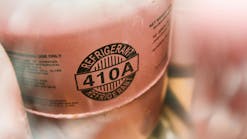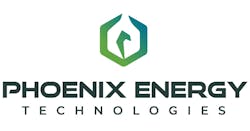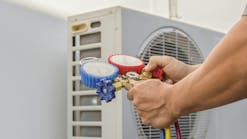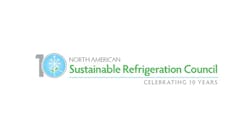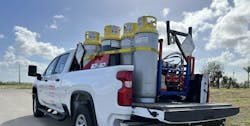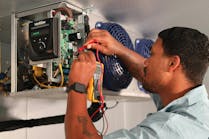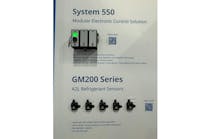Renewable energy — energy generated by an infinite, natural source — is being applied in numerous applications, such as home heating and automobiles.
Applying the technology to the commercial refrigeration industry is not as visible in the public eye, however there is some minor progress being made.
For this report, Contracting Business spoke to some leading energy experts, and scanned a sampling of energy websites, to get a picture of what the refrigeration industry can expect to see in the near future.
Solar Power and More\
“There’s no reason you couldn’t use solar energy to power a supermarket, but it’s not the most cost effective thing to do,” according to Hugh Henderson, P.E., a principal with CDH Energy, Cazenovia, NY.
“The payback on a solar array is about 50 years, maybe 20 or 30 years with incentives. If you had $1,000, and wanted to save the planet, you wouldn’t put the money down on a solar array; you’d buy better lights and more efficient compressors,” Henderson says. “A kWh saved from efficiency is just as good as one produced by a solar array, from a carbon emissions/ environmental point of view.”
Wind power could provide 20% of electricity consumed in the U.S. by 2030, according to a report from the U.S. Department of Energy (DOE) and supported by the National Renewable Energy Laboratory, Golden, CO. The catch is making it practical for an individual supermarket’s power generation needs.
“Wind-generated power will continue to contribute a larger share of our nation’s power production, but not as an on-site energy source because of siting issues for the turbines,” says Dan Dettmers, associate researcher at the Industrial Refrigeration Consortium, University of Wisconsin —Madison.
“Wind is one of the few forms of renewable energy that can be cost-competitive with coal,” Dettmers says. “However, onsite power generation is tough for supermarkets, regardless of its form, because it requires the loss of real estate (i.e., parking spaces, loading dock), or structural reinforcement of the building to place a generator on the roof. To be effective, wind turbines need a very large tower. They also make a considerable amount of noise that neighbors would find annoying.”
“There’s nothing specific for refrigeration systems that’s any different than any other building system, says Michael Deru, senior engineer for the National Renewable Energy Laboratory (NREL), Golden, CO. Deru has written on alternative energy topics for the American Society of Heating, Refrigeration, and Air Conditioning Engineers (ASHRAE).
“As far as electricity consumption goes, in the near future you’ll simply choose your renewable electricity source and apply it, whether it be wind or solar. There’s some research underway on solar-powered space air conditioning, but nothing else,” Deru says.
On the other hand, Deru says existing technology, like evaporative-cooled condensers, can help.
“Evaporative-cooled condensers can truly reduce energy use and peak load in summer. However, there are maintenance issues connected to waterbased systems. You can experience scale and biological growth issues, and water treatment concerns,” Deru says.
And while an evaporative condenser isn’t renewable energy per se, it allows the head pressure of the refrigeration system to be reduced significantly below the limitations set by typical air-cooled condensers. A reduction in head pressure leads to energy savings at the compressor.
“There’s much work being done on improving refrigeration system efficiency, reducing refrigerant charge, and going to secondary loops,” Deru says.
Dr. S.A. Klein, a researcher with the Solar Energy Laboratory Department of Mechanical Engineering, University of Wisconsin – Madison, doesn’t believe refrigeration systems will basically benefit from new sources in the same way other systems will.
“Do I envision supermarket equipment that’s designed to make use of solar energy in a form that’s different from electricity or natural gas? No. We’re talking about renewable methods of producing conventional energy used in a conventional way for conventional supermarkets. The only possibilities include wind and solar. There are some industrial applications in which thermal energy is needed for washing or cleaning, which opens the door to other types of solar energy collection, but that doesn’t sound to me like a supermarket application.”
Klein says natural lighting is gaining in popularity.
“Lighting is a great expense, and supermarkets and many big-box stores such as Wal-Mart are converting to natural lighting,” Klein says.
According to a 2002 report by NREL, some retailers have discovered the positive effect daylight has on shoppers, and are using daylighting to enhance the store environment, attract customers, and boost sales.
To power a facility using only renewable energy, many utilities are offering an alternative to on-site renewable power generation. Special green power purchasing contracts can be established, in which up to 100% of electricity can originate from renewable sources such as wind, solar, and hydro.
If a minimal amount of space is the largest deterrent to installing a greener system in a store, on-site generation using a combined heat and power (CHP) system may be your answer. CHP systems use a traditional source or a microturbine to produce electricity. Either technology can operate on a variety of fuels, including natural gas, sour gases (with high sulfur, low Btu content), and liquid fuels, such as gasoline, kerosene, and diesel fuel/ distillate heating oil. In resource recovery applications, they burn waste gases that would otherwise be flared or released directly into the atmosphere. After the fuel has been burned, heat from the exhaust gases is reclaimed to provide domestic hot water, heat the store, and heat water for a car wash or any other application that can use the heat. The primary issue that could stall a CHP system is the need for heat storage, or coincident loads that need both electricity and heat.
Microturbines, Fuel Cells
Microturbines have been gaining in popularity since 2000 due to their increased efficiency over generators. These small electric generators burn gaseous and liquid fuels to create high-speed rotation to turn an electric generator.
Microturbines range from 30 to 350 kW, while conventional gas turbine sizes range from 500 kW to 250 MW.
A report prepared for the Environmental Protection Agency says microturbines are best suited for distributed-generation applications due to their flexibility in connection methods, their ability to be stacked in parallel arrangements for larger loads, their stable and reliable power, and their low emissions.
Fuel cells are an up-and-coming technology that’s not quite ready for commercialization.
“Fuel cells fit right in with the microturbine, because they’ll probably be able to be used for combined heat and power,” Dettmers says.
Energy ‘Bird in the Hand’
As supermarket and convenience store managers — and their refrigeration contractors — seek to find their way in the green movement, it’s important to remember Hugh Henderson’s comment: “A kWh saved from efficiency is just as good as one produced by a solar array, from a carbon emissions/environmental point of view.”
When looking for ways to apply a capital improvement budget, consider the payback offered by simple improvements to the facility and its refrigeration systems, versus the cost of installing on-site energy generation.
Utility rebates the payback on simple items such as a lighting retrofit or refrigeration system improvement can be quite attractive.
